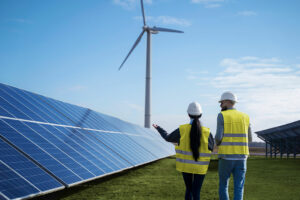By Sheldeen Joy Talavera, Reporter
RENEWABLES surpassing coal as the Philippines’ top energy source by 2025 may face challenges in power generation capacity, financing, and land acquisition, according to analysts.
“Intermittent wind-solar cannot and will not be able to replace or substitute coal generation unless we embrace and endure large-scale daily blackout,” Bienvenido S. Oplas, Jr., president of Minimal Government Thinkers, said in a Viber message last week.
The International Energy Agency (IEA) has projected that renewable energy is poised to surpass coal as the top source of global power supply by 2025.
“Renewables are expected to generate more than one-third of the world’s electricity in 2025, overtaking coal as the largest source of supply,” the IEA said in its annual report on the electricity market.
The share of renewables in power generation is expected to increase to 37% in 2026 from 30% in 2023, “with the growth largely supported by the expansion of ever-cheaper solar PV (photovoltaic),” the report also said.
Citing data from the Department of Energy (DoE), Mr. Oplas said that the combined power generation of wind and solar was 2,582 gigawatt-hours (GWh) or 2.6% of the total generation of 111,516 GWh in 2022, while coal accounted for 66,430 GWh or 57.7% of the total.
Mr. Oplas also noted the need for a significant addition to renewable capacity to meet economic growth and avoid frequent blackouts.
“Challenges to renewables especially intermittent wind-solar is that the Philippines is growing fast economically… We need at least 7-8 TWh (terawatt-hours)/year addition in 2024-2026… otherwise we cannot grow (GDP) 6% or more yearly as we will have frequent rotational blackout as demand keeps rising and supply is not catching up,” Mr. Oplas said.
Erel B. Narida, president of the Renewable Energy Association of the Philippines, said that with only a few takers in the recent green energy auction (GEA), it is “something that you would look into” due to the “financial sensitivity because of the rate.”
“There’s only a few that really have the financial muscle to do that and with that, you require foreign direct investments for that,” he said.
During the second round of the GEA conducted last year, the DoE offered a total capacity of 11,600 megawatts (MW), but only 3,440 MW of renewable energy capacity was auctioned off.
The GEA program aims to promote renewable energy as a primary source of energy through competitive selection.
“The most challenging in the development is actually land acquisition, that’s one thing that really hinders some of the development,” Mr. Narida said.
Terry L. Ridon, a public analyst and convenor of think tank InfraWatch PH, said that developing economies such as the Philippines “are not under obligation” to make binding commitments to climate and renewable energy goals, unlike developed nations with their “massive industrialization.”
“At our current stage of economic development and limited land areas for food production, the nation cannot yet dispense with baseload technologies such as coal, oil, and gas, without incurring significant energy costs detrimental to the public,” he said in a Viber message.
With the share of renewables at 22% in the country’s power mix, the government is targeting an increase to 35% by 2030 and 50% by 2040.
